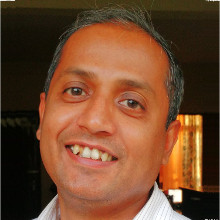[Painting : David and Goliath by Ilya Repin under Public Domain via Wikimedia Commons]
There is a new game in town. Acquire online users fast, whatever the costs be. A top honcho running a leading consumer site told me recently: "What you spend in a month, we spend in a day."
Now, I am sure his point had a lot to do with the scale of his operations. But I know of others like him with war chests that propel them into leadership positions by spending furiously. What about the rest of us who don't?
In my experience, it is possible to play the game with limited resources. I learnt of this by trial and error, over the last two years, on our research and advisory site for cars, CarToq.com.
CarToq.com is today the Number 2 media site in auto, and is also the leading social site on Facebook, ahead of even category leaders such as Cardekho, Carwale, etc. We use Facebook to reach out to 10 million people each month. Our site attracts over two million visits every month and it is growing at the rate of 15-20% month on month. Six months ago, we were nowhere in the game. In auto, we were probably ranked 15th or whatever. In hindsight, for over one and a half years, we weren't doing a few things right.
Focus: Think Minimum Viable Product (MVP) we are always told. But that’s easier said than done.
The problem, I believe, is to do with the nature of the key enabler in business today: Technology. More choices, at a faster pace, at cheaper costs—that is what technology makes possible continuously.
At CarToq.com, we started with a focus on providing real-time advice through Q&A. But before we built this value proposition out fully, we were adding news widgets, and car research tools. Why? Because news widgets are easily available plug-ins, and research tools just need an attractive user interface plugged into a mySQL database.
Staying the course when faced with attractive new possibilities all the time is the hardest challenge. We have a new rule now: Unless a new feature directly impacts the quarter's primary goal, we won't add it.
Quality: In the last 2 months, in response to our new leadership position on Facebook, competition ramped up their social publishing by over 300-400 percent in some cases!
Is that delivering results for them? I doubt it. Our user base continues to grow.
We used to publish a lot earlier, often anywhere between 30 to 35 items daily with 8/9 pieces of original content and 25-30 curated items from other sites. As we published more, we saw visits per article plateau, and then actually dip. Cumulative numbers were still rising, but torturously.
The diminishing returns were even more evident on Facebook. As we published more posts, our organic reach per post dropped, from 40,000 to almost 15,000 people per post.
That's when we decided to try the fewer-better approach. Where most ideas were earlier allowed to go through, 9 out of 10 ideas get rejected now. It was initially tough on our content team—morale would sap when most ideas wouldn't go through. But then the graph started rising. Today, we sometimes have posts on Facebook that garner organic reach exceeding a million users.
Flexibility: Keeping up with the fast-changing digital landscape requires a highly adaptive approach. Just 8 months ago, mobile traffic was 30% of our total traffic. Today, it is close to 75%, and rising. We had a basic mobile site, and this sudden shift in traffic caught us by surprise.
We pushed back a major product release, something the senior team had been working on for many months and changed our plans to focus on building the new mobile site first.
Three months ago, we had no plans for a mobile app; now we will roll out an app for our premium and super users in the next month. For those who spend a good amount of time on our site, we want to craft a more customized experience for them on the mobile.
We are learning to be more agile. Fewer decisions are made at the top now; there is a lot more delegation. We are looking for different things when we recruit new staff. In our hiring, we have a favorite question: "Today, this is the job description. But tomorrow, you could be doing a different bunch of things." Only those who are not rattled by this possibility get through.
We have also de-emphasized hierarchy at every opportunity. I interact directly with junior staff as much as with more experienced people. Approvals do not go through any chain of command. Just recently, our email marketer found a cheaper emailer solution. He decided to switch to the new system. The product head found out about the switch when he got a test mailer. And so on.
Always-on: Our origins as a company lie in media outsourcing business, where we have 24X7 operations for newspapers and magazines across time-zones in Asia, Europe and the US.
That allowed us assume we have this part covered. But we found the online world even more demanding. Online is not a daily schedule. It means executing every hour. It is not five-day-work week. It means a seven-day 24/7 grind.
While our digital operations have been real-time, earlier we weren't as focused on real-time analytics as we are now. End-of-the-day reports and reviews were useful but we started uncovering a lot more insights by studying real-time data feeds. We have built some custom tools that track live audience on different stories all the time. The content team has a single-click view of how each story is doing.
We found, for instance, that with mobile users, content consumption on our site stays high even late into the night, often until midnight. More interestingly, stories that clicked during the day did not necessarily do as well in the night.
Our production schedules are now more closely aligned with user habits—which we know will still keep changing all the time. All we can do is to watch closely, adapt swiftly to changes while staying focused on our core value proposition.
Every morning, the product head shares the previous day's analytics with the entire team. More importantly, he shares key insights from that data. It's a short mail, but it goes out daily, and it forms our planning for the day. This practice has brought in a healthy data insights driven approach to our daily execution.
With focus, quality, flexibility and relentless optimization, you can take the game much farther. Especially if you have limited resources to play with.


